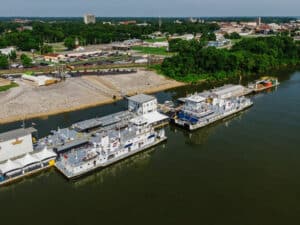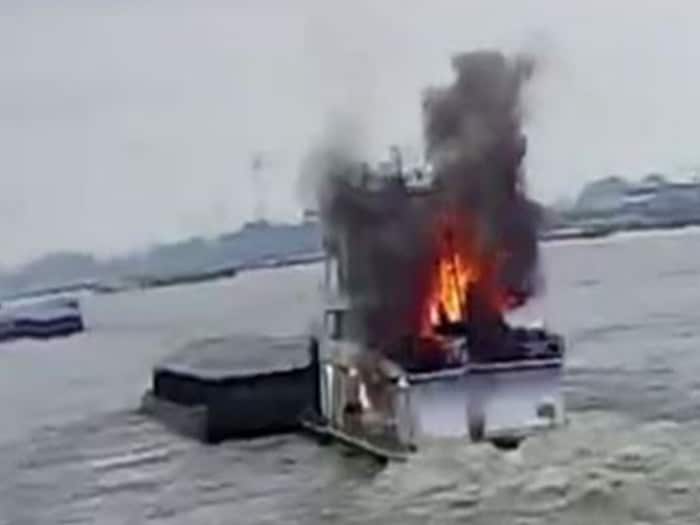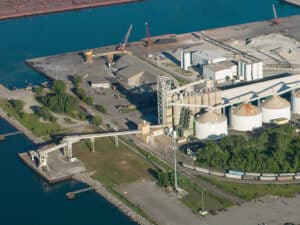
NTSB reports on $700,000 fire on 64-year old towboat
Written by Marine Log Staff
Engine room fire was caused by fuel system overpressurization, says NTSB [Image: American River Transportation Company/NTSB]
An engine room fire aboard a towing vessel was caused by overpressurization of the fuel day tank and a main engine fuel return system when a fatigued chief engineer inadvertently left the day tank overflow valves to the storage tanks closed, the National Transportation Safety Board says in a report released Wednesday.
On May 18, 2021, at about 6.53 p.m. local time, the 1957-built towing vessel Mary Lynn, operated by Hermann Sand and Gravel on lease from Missouri River Towing, was pushing two barges near mile 176 on the Upper Mississippi River near St. Louis, Missouri when a fire broke out in the engine room. A Good Samaritan towing vessel and a St. Louis Fire Department fire boat helped extinguish the fire. No pollution or injuries to the six-member crew were reported. The fire resulted in damages of over $700,000.
Earlier that day, at about 3.15 p.m., the Mary Lynn had tied up at the Gasconade Street fleet after dropping off barges. The crew planned to take on fuel, lube oil and potable water from a delivery tug and barge. The delivery tug arrived about 2.5 hours early, as the chief engineer was dewatering the fuel storage tanks. While preparing for the delivery, the chief engineer inadvertently left the day tank overflow valves to the fuel storage tanks closed.
Almost immediately after the Mary Lynn got under way, at about 6.17 p.m., the starboard main engine failed to meet the ordered rpm, and the captain brought the vessel back to the fleeting area to troubleshoot the issue. While the chief engineer was troubleshooting, he opened the suction valves to one of the tow’s fuel storage tanks and started a fuel transfer pump, which had been turned off during fueling and had not been restarted before getting under way, as was the vessel’s standard procedure.
About 13 minutes after the Mary Lynn got back under way, the chief engineer saw a fuel filter sight glass bowl blow off the port main engine fuel header, causing fuel to spray and ignite. The chief engineer evacuated the space. The vessel lost electrical power shortly after, and nearby Good Samaritan vessels responded to provide firefighting and tow assistance efforts.
A post fire examination found that a section of exhaust header between the port main engine block and horizontal portions of the exhaust manifold, as well as nearby cylinder test valves, did not have thermal protection. The fire likely originated near these uninsulated components.
NTSB investigators also concluded the chief engineer was likely affected by acute fatigue as he reported receiving less than five hours of sleep in the 24 hours preceding the fire. This fatigue likely impacted the chief engineer’s attention, memory and performance of complex tasks.
The NTSB determined the probable cause of the engine room fire on board the Mary Lynn was the overpressurization of the fuel day tank (which did not have an independent vent) and a main engine fuel return system when the fatigued chief engineer inadvertently left the day tank overflow valves to the storage tanks closed, which ultimately led to ignition of spraying diesel fuel from a main engine’s fuel system onto an uninsulated engine component.
“Subchapter M regulations for towing vessels require vessels built after 2000 to have vents for each fuel tank,” the report said. “Regulations for vessels ranging from small passenger vessels to cargo ships require that fuel tanks be independently vented from the highest point of the tank to atmosphere on a weather deck. Tank ventilation is important to ensure a valve line up error does not lead to the overpressurization of or vacuum in a fuel tank. Operators should be aware of their fuel tank ventilation system arrangements. On vessels without independent fuel day tank ventilation, it is critical to ensure proper valve position during transfer and operation of the fuel system.”
“The fuel tank venting regulations did not apply to the Mary Lynn, since the vessel was built before 2000,” the report noted. “The design of the Mary Lynn’s system allowed for the potential pressurization of the day tank to exceed atmospheric pressure if a crewmember secured valves on other tanks. Had the Mary Lynn’s day tank been fitted with its own vent line, even with the fuel return lines inadvertently left closed, the overpressurization of the return line would have not occurred.”
Download Marine Investigation Report 22/17

![Tom Frazier aground and listing to starboard on Feb. 11, 2024. [Photo: U.S. Coast Guard]](https://www.marinelog.com/wp-content/uploads/2025/06/Towboataground-300x225.jpg)


